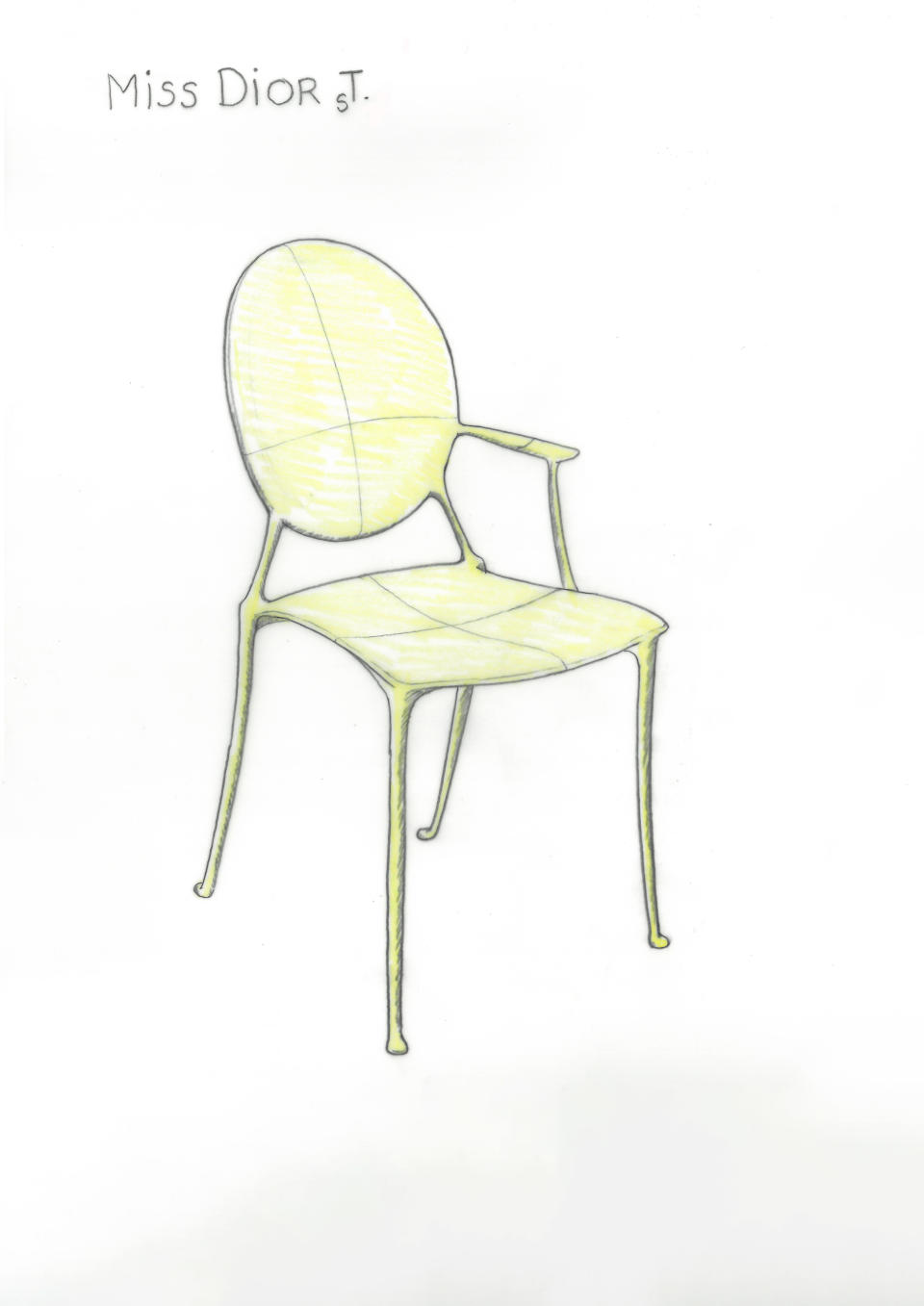EXCLUSIVE: Dior Taps Philippe Starck to Reinterpret Medallion Chair
- Oops!Something went wrong.Please try again later.

PARIS — Just as a fashion designer might spend a lifetime creating the perfect little black dress, Philippe Starck is obsessed with making the ideal chair.
With his new collaboration with Dior, due to be unveiled at the Salone del Mobile furniture fair in Milan, he thinks he’s nailed it. Starck, who is behind iconic designs like the transparent Louis Ghost, was commissioned to put his spin on another medallion chair: the Louis XVI-style model that has been a symbol of Dior since the house was founded in 1947.
More from WWD
The designer, who describes his ethos as a constant striving for minimalist perfection, stripped the classic chair down to its bare bones, and chose to make it in aluminum to emphasize the lightness and purity of its silhouette.
“I can tell you that right now, nothing can be ‘less’ than this chair, and that requires a huge amount of work. You have to literally whittle it down. You have to know the technology,” he told WWD in a Zoom interview.
“I worked to create a totally timeless, definitive design, an icon, so that it will never go out of style,” he added. “We’re right down to the skeleton of the object. That’s why there are very biomorphic shapes in this chair. Semantically, stylistically, we’ve reached the bare minimum.”

Courtesy of Dior
The chair will be the centerpiece of the “Dior by Starck” exhibition, due to run from June 7 to 12 at Palazzo Citterio in Milan, which can be visited by prebooking a time slot online. Starck has commissioned sound artist Stephan Crasneanscki to create a soundtrack for the show, inspired by the imagined life of Miss Dior.
The solo presentation reflects Starck’s stature in the design world. For last year’s Salone del Mobile, Dior commissioned more than a dozen participants, including Pierre Yovanovitch, India Mahdavi and Oki Sato of Japanese design firm Nendo, to revisit the medallion chair.
Working with decorator Victor Grandpierre, founder Christian Dior introduced the streamlined neoclassical style that came to define the Dior universe. The oval-back chair was a feature of his couture salon, as well as his store decor, beginning with the brand’s first boutique on Avenue Montaigne.
Starck said the design had entered collective memory, making the collaboration feel natural.
Dubbed Miss Dior, his take presented a logistical challenge. Only one injector, located in Italy, was capable of creating a mold to produce the chair, which is less than one centimeter thick in places. It comes in three models, featuring one, two or no armrests, priced from 1,500 euros to 5,000 euros.
“I chose a difficult material that’s designed to last. It’s made of recyclable aluminum that is very special, quite expensive and rock solid. There’s no reason for this chair ever to break, and that’s already an extraordinary guarantee when you buy it. You know it’s something that can be handed down,” Starck explained.
The designer, who has always promoted democratic products like his 1989 curved toothbrush for Fluocaril, said the project would have been impossible to achieve without a luxury partner like Dior, willing to invest heavily in the production process.
“I’ve always pushed to keep costs down so that everyone can have access to quality design,” he said. “Given the choice, obviously, I would always prefer that. But there are other people who can afford this. Why deny them?”

Courtesy of Dior
The Miss Dior chair telegraphs luxury, with galvanized metallic finishes including pink copper, black chromium and gold, available in satinated or polished versions. By contrast, the polycarbonate Louis Ghost, produced by Kartell, retails for less than 350 euros — though Starck stands by his use of plastic.
“I don’t change with the wind,” he said. “I will always defend my use of plastic, because I did it for environmental reasons, which is to say that when I make a plastic chair, I don’t cut any trees and I don’t kill any animals.”
Starck notes that the polycarbonate used in the Louis Ghost chair is made from renewable raw materials. “I’ve spent a lot of time working with manufacturers, and today, there are bio-sourced plastics. I’ve been waiting for this moment for 20 years,” he noted.
The designer, who is based in Portugal, is also thinking about more significant ways to reduce our environmental footprint. He’s working on a state-of-the-art complex for space training company Orbit that is designed to leave no trace.
“We’re building a city, but reinventing all the parameters. I want it to be the first reversible town, meaning it can disappear in three months and have the smallest possible footprint,” he explained. “In addition to training people for space, which is the future of the world, I’m potentially creating the cities of the future, too.”
Up next is space itself: commercial space station Axiom Space has commissioned Starck to create the crew quarters inside its privately developed modules, which will be attached to the International Space Station. Expect nest-like interiors sprinkled with hundreds of LED lights with changing colors.
As challenging as that sounds, he believes that nothing is harder to design than a chair, and it will be difficult to top the Miss Dior. “Like a lot of couturiers, I have always been on the quest for the little black dress,” he said. “In terms of chairs, now there is this one.”
SEE ALSO:
Dior Medallion Chair Exhibition to Make U.S. Debut
Dior Supports Venice Biennale as Women Artists Move to the Fore
Dior Lady Art Handbag Show Heads to China
Best of WWD
Sign up for WWD's Newsletter. For the latest news, follow us on Twitter, Facebook, and Instagram.

